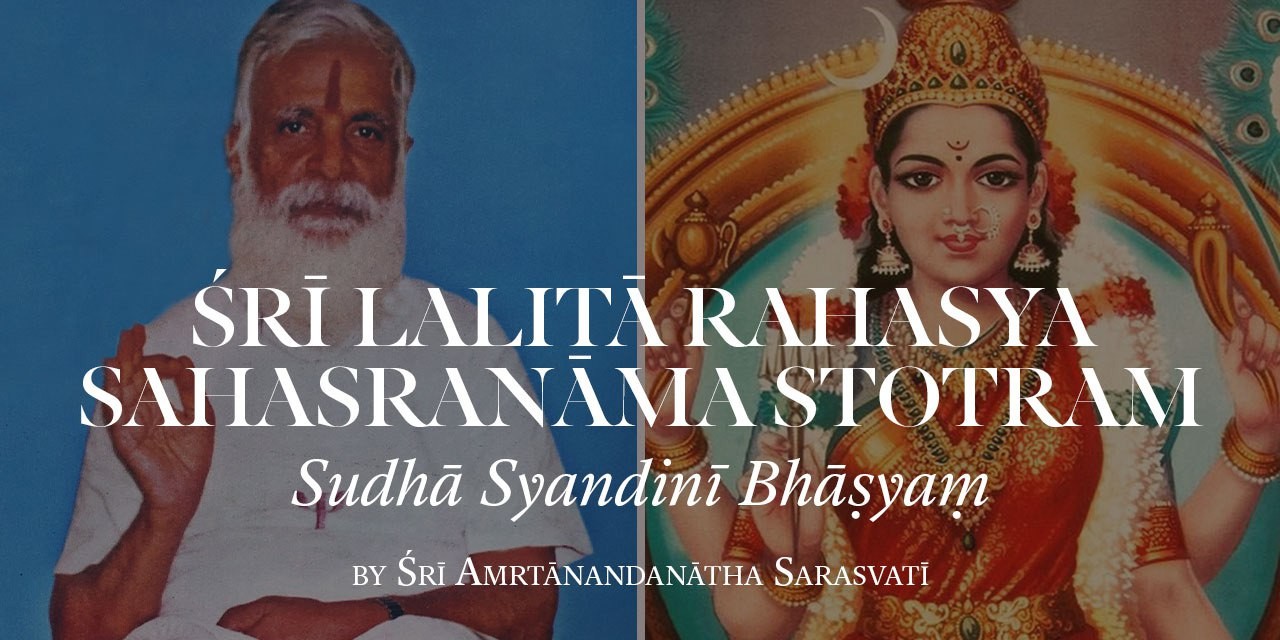
27) Nija-sallāpa-mādhurya-vinirbhartsita-kacchapī
Her own lilting conversation defeats the melodious musical instrument called Veena. The word nija can also mean truthful. Here both meanings are appropriate.
Upāsana of Mātaṅgī is based on observing the sound of praṇava at the Anāhata with an undistracted mind. In the sound of Oṁkāra, all music lies. When one hears this music of the spheres, and one merges into that, the truth of Lalitā's voice excelling in sweetness the sweetness of Veena is experienced. These musical forms heard in meditation have been variously called the flute of Kṛṣṇa, the songs of celestial musicians like Nārada, Tumburu, Kinnaras, etc. Thus Her own voice is the inner voice of God heard in meditations which leads one to higher truths such as the great sentences (mahāvākyas) of the Vedas and Upaniṣads, which are five in number.
The first is “Prajñānam Brahma” which means: All knowing is Brahman.
The others are “Ayam atma Brahma” = This witness in you is Brahman.
“Tat tvam asi” = You are that (Brahman which you see).
“So’haṃ” = That (Brahman) is I.
“Neha nānāsti kiṃcana” = There is no such variety here as this illusory appearance seems to indicated.
The first three of these crowning sentences from Ṛg, Yajur, Sama Vedas are the fundamental teaching of the Guru to the disciple. The next one is from Atharva Veda, an exclamation by a disciple who has realized as experience the truth of the first three statements, and is indeed a mantra par excellence called Ajapa Gāyatrī. The last jewel is from the Upaniṣads, which are the essential parts of the Vedas dealing exclusively with the knowledge of Brahman, and do not concern themselves at all with ritual. All mantras are born out of the ocean of sound contained within the praṇava. The Vedas themselves have arisen out of praṇava in the hearts of ṛṣis (sages) as revealed knowledge of Godhead.
This mantra So’haṃ is a very important mantra. The sacred texts say this about this mantra.
hakāreṇa bahiryāti sakāreṇa punarviśet
ajapā nāma gāyatrī jīvo japati sarvadā
This means: The breath goes out with the sound of “ha” and comes back into the heart with the sound of “so”; the mind gets absorbed in the junction sound “m” between them. This mantra called So’haṃ is recited by every living soul always whether one knows it or not. The very process of breathing is this mantra So’haṃ.
Also; sa means Śakti, ha means Śiva, their union is the bindu ṁ. The union is effected by Oṁ. So’ham = Sa + O + Ha + Ṁ. This Oṁ interpenetrates as O and Ṁ separately between Śakti and Śiva first and Śiva and Śakti next.
O itself is the union of A and U. A stands for Nirguna Brahman, the unmanifest. U stands for the awareness of existence. This greatness of this mantra is thus many fold.
Firstly, it is representing the life defining breathing process, the biological clock.
Secondly, it describes the creation of cosmos to be on the same level as the creation of the individual.
The cosmos is created by the union of Brahman with his power to manifest, which is simply awareness, or consciousness, or existence, which are all really synonymous terms.
The creation of the individual life begins simultaneously through the union of the male principle (Śiva or the liṅga) with the female principle (Śakti).
Thus this mantra reveals to the enquiring mind that the bliss of physical union of the sexes is really the bliss of Brahman manifesting itself. This is why there are no two separate persons in union at the time of orgasm, but there is something which is neither the male nor the female but a new unmanifest life. To the brahmajñāni, or the one who has known Brahman, the mantra is the witnessing of the supreme creative bliss of Brahman with every breath! The Upaniṣads say: “Brahma veda brahmaiva bhavati”, meaning, the one who's known Brahman does, of necessity, become Brahman.
Lalitā imparts such deep knowledge to Her devotees in meditation that it is music to their ears. Since it is coupled with the joy of Brahman which is described as 10 times the orgasmic bliss, Veena is not an instrument that can match this power to give ecstasy.
Source: Śrī Amṛtānandanātha Saraswatī "Sudhā Syandinī Bhāṣyaṃ" Typed Manuscript
(an incomplete commentary on Lalitā Sahasranāma)
